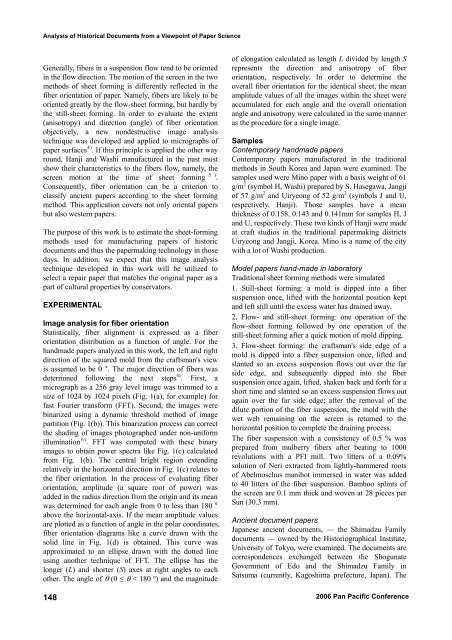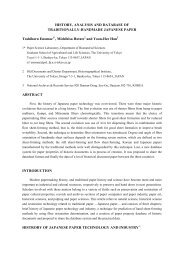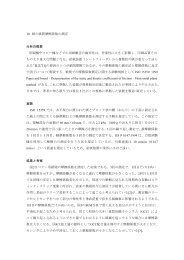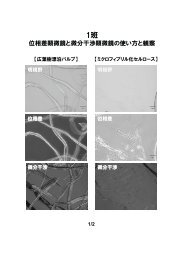Analysis of Historical Documents from a Viewpoint of Paper Science
Analysis of Historical Documents from a Viewpoint of Paper Science
Analysis of Historical Documents from a Viewpoint of Paper Science
You also want an ePaper? Increase the reach of your titles
YUMPU automatically turns print PDFs into web optimized ePapers that Google loves.
<strong>Analysis</strong> <strong>of</strong> <strong>Historical</strong> <strong>Documents</strong> <strong>from</strong> a <strong>Viewpoint</strong> <strong>of</strong> <strong>Paper</strong> <strong>Science</strong><br />
Generally, fibers in a suspension flow tend to be oriented<br />
in the flow direction. The motion <strong>of</strong> the screen in the two<br />
methods <strong>of</strong> sheet forming is differently reflected in the<br />
fiber orientation <strong>of</strong> paper. Namely, fibers are likely to be<br />
oriented greatly by the flow-sheet forming, but hardly by<br />
the still-sheet forming. In order to evaluate the extent<br />
(anisotropy) and direction (angle) <strong>of</strong> fiber orientation<br />
objectively, a new nondestructive image analysis<br />
technique was developed and applied to micrographs <strong>of</strong><br />
paper surfaces 4) . If this principle is applied the other way<br />
round, Hanji and Washi manufactured in the past must<br />
show their characteristics to the fibers flow, namely, the<br />
screen motion at the time <strong>of</strong> sheet forming 5 ) .<br />
Consequently, fiber orientation can be a criterion to<br />
classify ancient papers according to the sheet forming<br />
method. This application covers not only oriental papers<br />
but also western papers.<br />
The purpose <strong>of</strong> this work is to estimate the sheet-forming<br />
methods used for manufacturing papers <strong>of</strong> historic<br />
documents and thus the papermaking technology in those<br />
days. In addition, we expect that this image analysis<br />
technique developed in this work will be utilized to<br />
select a repair paper that matches the original paper as a<br />
part <strong>of</strong> cultural properties by conservators.<br />
EXPERIMENTAL<br />
Image analysis for fiber orientation<br />
Statistically, fiber alignment is expressed as a fiber<br />
orientation distribution as a function <strong>of</strong> angle. For the<br />
handmade papers analyzed in this work, the left and right<br />
direction <strong>of</strong> the squared mold <strong>from</strong> the craftsman's view<br />
is assumed to be 0 °. The major direction <strong>of</strong> fibers was<br />
determined following the next steps 4) . First, a<br />
micrograph as a 256 gray level image was trimmed to a<br />
size <strong>of</strong> 1024 by 1024 pixels (Fig. 1(a), for example) for<br />
fast Fourier transform (FFT). Second, the images were<br />
binarized using a dynamic threshold method <strong>of</strong> image<br />
partition (Fig. 1(b)). This binarization process can correct<br />
the shading <strong>of</strong> images photographed under non-uniform<br />
illumination 6 ) . FFT was computed with these binary<br />
images to obtain power spectra like Fig. 1(c) calculated<br />
<strong>from</strong> Fig. 1(b). The central bright region extending<br />
relatively in the horizontal direction in Fig. 1(c) relates to<br />
the fiber orientation. In the process <strong>of</strong> evaluating fiber<br />
orientation, amplitude (a square root <strong>of</strong> power) was<br />
added in the radius direction <strong>from</strong> the origin and its mean<br />
was determined for each angle <strong>from</strong> 0 to less than 180 °<br />
above the horizontal-axis. If the mean amplitude values<br />
are plotted as a function <strong>of</strong> angle in the polar coordinates,<br />
fiber orientation diagrams like a curve drawn with the<br />
solid line in Fig. 1(d) is obtained. This curve was<br />
approximated to an ellipse drawn with the dotted line<br />
using another technique <strong>of</strong> FFT. The ellipse has the<br />
longer (L) and shorter (S) axes at right angles to each<br />
other. The angle <strong>of</strong> θ (0 ≤ θ < 180 º) and the magnitude<br />
148<br />
<strong>of</strong> elongation calculated as length L divided by length S<br />
represents the direction and anisotropy <strong>of</strong> fiber<br />
orientation, respectively. In order to determine the<br />
overall fiber orientation for the identical sheet, the mean<br />
amplitude values <strong>of</strong> all the images within the sheet were<br />
accumulated for each angle and the overall orientation<br />
angle and anisotropy were calculated in the same manner<br />
as the procedure for a single image.<br />
Samples<br />
Contemporary handmade papers<br />
Contemporary papers manufactured in the traditional<br />
methods in South Korea and Japan were examined. The<br />
samples used were Mino paper with a basis weight <strong>of</strong> 61<br />
g/m 2 (symbol H, Washi) prepared by S. Hasegawa, Jangji<br />
<strong>of</strong> 57 g/m 2 and Uiryeong <strong>of</strong> 52 g/m 2 (symbols J and U,<br />
respectively, Hanji). Those samples have a mean<br />
thickness <strong>of</strong> 0.158, 0.143 and 0.141mm for samples H, J<br />
and U, respectively. These two kinds <strong>of</strong> Hanji were made<br />
at craft studios in the traditional papermaking districts<br />
Uiryeong and Jangji, Korea. Mino is a name <strong>of</strong> the city<br />
with a lot <strong>of</strong> Washi production.<br />
Model papers hand-made in laboratory<br />
Traditional sheet forming methods were simulated<br />
1. Still-sheet forming: a mold is dipped into a fiber<br />
suspension once, lifted with the horizontal position kept<br />
and left still until the excess water has drained away.<br />
2. Flow- and still-sheet forming: one operation <strong>of</strong> the<br />
flow-sheet forming followed by one operation <strong>of</strong> the<br />
still-sheet forming after a quick motion <strong>of</strong> mold dipping.<br />
3. Flow-sheet forming: the craftsman's side edge <strong>of</strong> a<br />
mold is dipped into a fiber suspension once, lifted and<br />
slanted so an excess suspension flows out over the far<br />
side edge, and subsequently dipped into the fiber<br />
suspension once again, lifted, shaken back and forth for a<br />
short time and slanted so an excess suspension flows out<br />
again over the far side edge; after the removal <strong>of</strong> the<br />
dilute portion <strong>of</strong> the fiber suspension, the mold with the<br />
wet web remaining on the screen is returned to the<br />
horizontal position to complete the draining process.<br />
The fiber suspension with a consistency <strong>of</strong> 0.5 % was<br />
prepared <strong>from</strong> mulberry fibers after beating to 1000<br />
revolutions with a PFI mill. Two litters <strong>of</strong> a 0.09%<br />
solution <strong>of</strong> Neri extracted <strong>from</strong> lightly-hammered roots<br />
<strong>of</strong> Abelmoschus manihot immersed in water was added<br />
to 40 litters <strong>of</strong> the fiber suspension. Bamboo splints <strong>of</strong><br />
the screen are 0.1 mm thick and woven at 28 pieces per<br />
Sun (30.3 mm).<br />
Ancient document papers<br />
Japanese ancient documents, — the Shimadzu Family<br />
documents — owned by the Historiographical Institute,<br />
University <strong>of</strong> Tokyo, were examined. The documents are<br />
correspondences exchanged between the Shogunate<br />
Government <strong>of</strong> Edo and the Shimadzu Family in<br />
Satsuma (currently, Kagoshima prefecture, Japan). The<br />
2006 Pan Pacific Conference

















